File Info
| Exam | NetApp Certified 7-Mode Data Administrator |
| Number | NS0-155 |
| File Name | Network Appliance.NS0-155.Train4Sure.2018-12-09.109q.vcex |
| Size | 888 KB |
| Posted | Dec 09, 2018 |
| Download | Network Appliance.NS0-155.Train4Sure.2018-12-09.109q.vcex |
How to open VCEX & EXAM Files?
Files with VCEX & EXAM extensions can be opened by ProfExam Simulator.
Coupon: MASTEREXAM
With discount: 20%
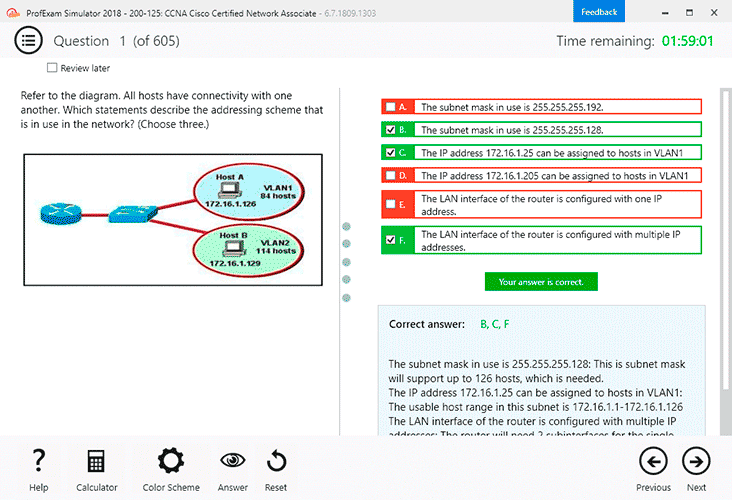
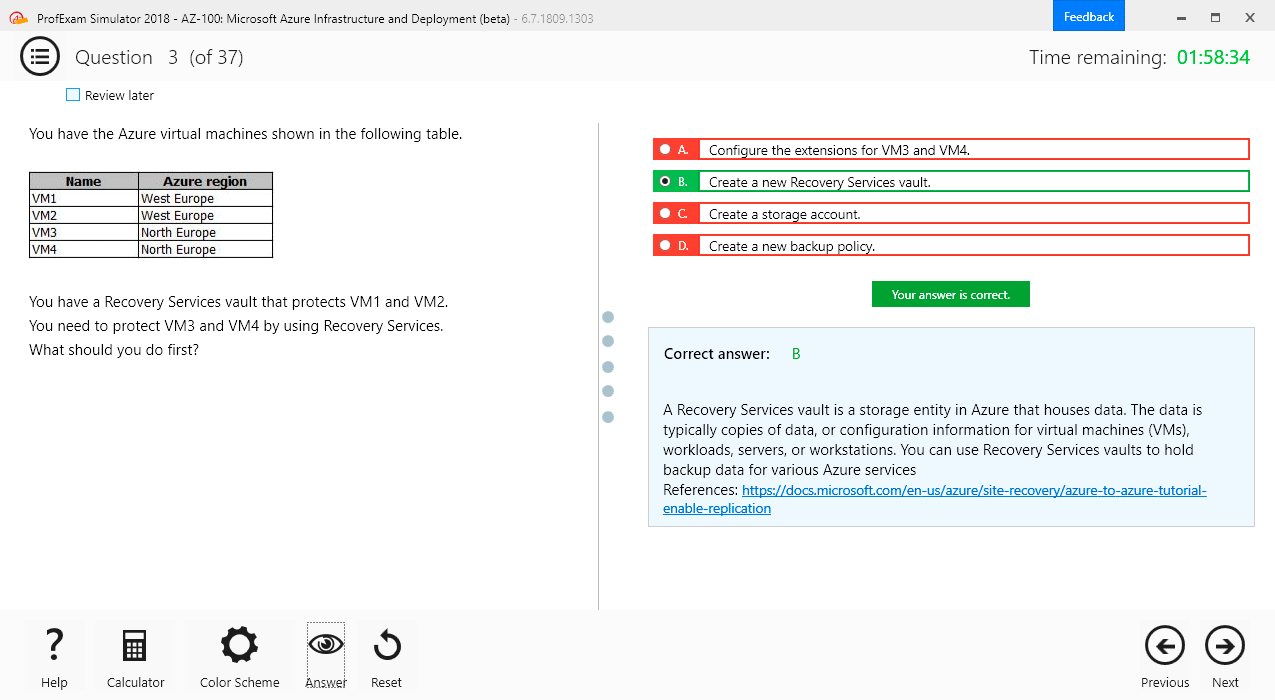
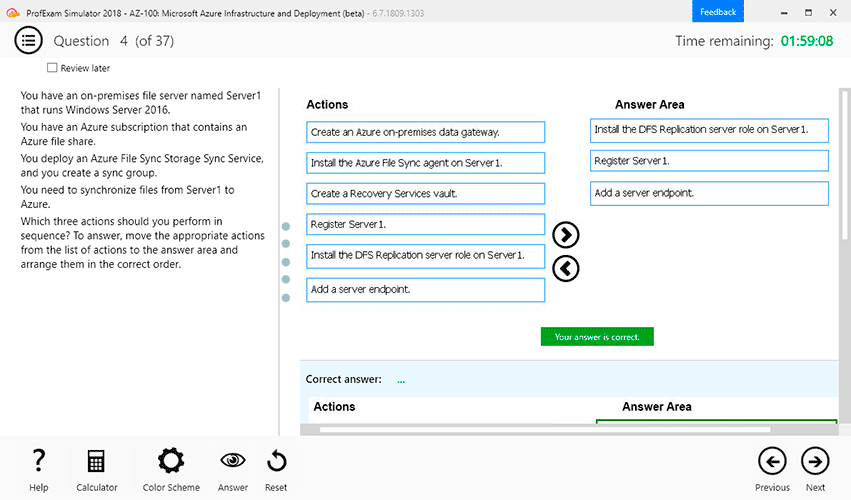
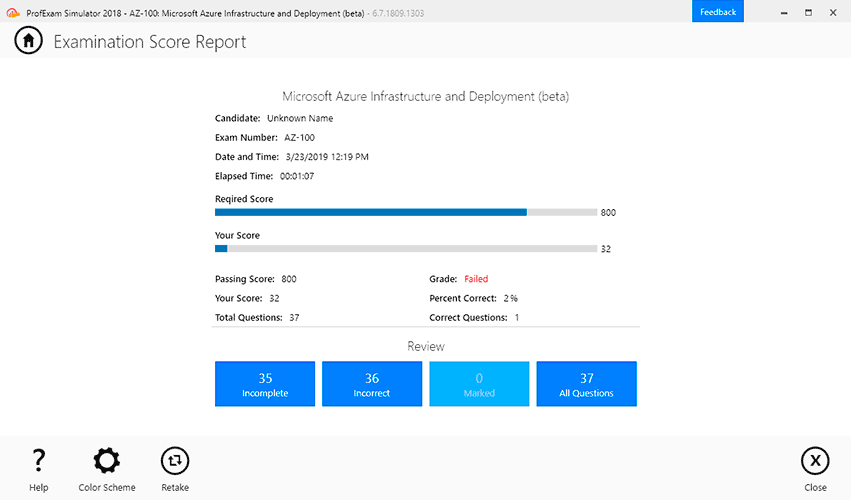
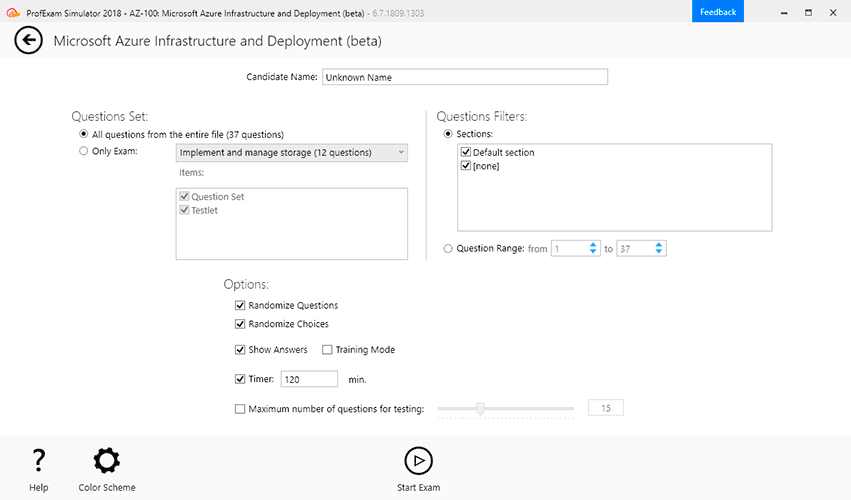

Demo Questions
Question 1
Which two operations can be performed with the SnapDrive for windows graphical user interface?
- Create volume
- Create Snapshot copies
- Create File
- Create Disk
Correct answer: BD
Explanation:
https://library.netapp.com/ecm/ecm_download_file/ECMM1278920What SnapDrive does SnapDrive software integrates with the Windows Volume Manager so that NetApp filers can serve as virtual storage devices for application data in Windows 2000 Server and Windows Server 2003 environments. SnapDrive is dependent on the virtual disk service. The virtual disk service must be started on the host prior to installing SnapDrive. SnapDrive manages virtual disks (LUNs) on a NetApp filer, making these virtual disks available as local disks on Windows hosts. This allows Windows hosts to interact with the virtual disks just as if they belonged to a directly attached redundant array of independent disks (RAID). SnapDrive provides the following additional features:It enables online storage configuration, virtual disk expansion, and streamlined management. It integrates NetApp Snapshot technology, which creates point-in-time images of data stored on virtual disks. It works in conjunction with SnapMirror® software to facilitate disaster recovery from either asynchronously or synchronously mirrored destination volumes. https://library.netapp.com/ecm/ecm_download_file/ECMM1278920
What SnapDrive does
SnapDrive software integrates with the Windows Volume Manager so that NetApp filers can serve as virtual storage devices for application data in Windows 2000 Server and Windows Server 2003 environments.
SnapDrive is dependent on the virtual disk service. The virtual disk service must be started on the host prior to installing SnapDrive. SnapDrive manages virtual disks (LUNs) on a NetApp filer, making these virtual disks available as local disks on Windows hosts. This allows Windows hosts to interact with the virtual disks just as if they belonged to a directly attached redundant array of independent disks (RAID).
SnapDrive provides the following additional features:
It enables online storage configuration, virtual disk expansion, and streamlined management.
It integrates NetApp Snapshot technology, which creates point-in-time images of data stored on virtual disks.
It works in conjunction with SnapMirror® software to facilitate disaster recovery from either asynchronously or synchronously mirrored destination volumes.
Question 2
Which storage system command would display the WWPNs of hosts that have logged into storage system using a Fibre Channel connection?
- fcp config
- fcp initiator show
- fcp show –i
- fcp show initiator
Correct answer: D
Explanation:
https://library.netapp.com/ecmdocs/ECMP1196979/html/man1/na_fcp.1.html fcp show initiator [ -v ] [ adapter ] If no adapter name is given, information about all initiators connected to all adapters are shown. The command displays the portname of initiators that are currently logged in with the Fibre Channel target adapters. If the portname is in an initiator group setup through the igroup command, then the group name is also displayed. Similarly, all aliases set with the fcp wwpn-alias command for the portname are displayed as well. If the -v flag is given, the command displays the Fibre Channel host address and the nodename/portname of the initiators as well. https://library.netapp.com/ecmdocs/ECMP1196979/html/man1/na_fcp.1.html
fcp show initiator [ -v ] [ adapter ]
If no adapter name is given, information about all initiators connected to all adapters are shown.
The command displays the portname of initiators that are currently logged in with the Fibre Channel target adapters. If the portname is in an initiator group setup through the igroup command, then the group name is also displayed. Similarly, all aliases set with the fcp wwpn-alias command for the portname are displayed as well.
If the -v flag is given, the command displays the Fibre Channel host address and the nodename/portname of the initiators as well.
Question 3
Which action will cause a currently in-sync SnapMirror relationship to fail out of sync?
- Running snapmirroe update on the source storage system.
- Running snapmirror release on the source storage system.
- Modifying the /etc/snapmirror.conf file for the relationship on the source storage system
- Modifying the /etc/snapmirror.conf file for the relationship on the destination storage system.
Correct answer: D
Explanation:
https://library.netapp.com/ecmdocs/ECMP1196979/html/man1/na_snapmirror.1.htmlhttps://library.netapp.com/ecmdocs/ECMP1196979/html/man5/na_snapmirror.conf.5.htmlsnapmirror update [ -S source ] [ -k kilobytes ] [ -s src_snap ] [ -c create_dest_snap ] [ -w ] destination For asynchronous mirrors, an update is immediately started from the source to the destination to update the mirror with the contents of the source. For synchronous mirrors, a snapshot is created on the source volume which becomes visible to clients of the destination volume. The snapmirror update command must be issued on the destination filer. snapmirror release source { filer:volume | filer:qtree }Tell SnapMirror that a certain direct mirror is no longer going to request updates. If a certain destination is no longer going to request updates, you must tell SnapMirror so that it will no longer retain a snapshot for that destination. This command will remove snapshots that are no longer needed for replication to that destination, and can be used to clean up SnapMirror-created snapshots after snapmirror break is issued on the destination side. The source argument is the source volume or qtree that the destination is to be released from. The destination argument should be either the destination filer and destination volume name or the destination filer and destination qtree path. You can use a line from the output of the snapmirror destinations command as the set of arguments to this command. The /etc/snapmirror.conf file exists on the node containing the mirror used for SnapMirror. https://library.netapp.com/ecmdocs/ECMP1196979/html/man1/na_snapmirror.1.html
https://library.netapp.com/ecmdocs/ECMP1196979/html/man5/na_snapmirror.conf.5.html
snapmirror update [ -S source ] [ -k kilobytes ] [ -s src_snap ] [ -c
create_dest_snap ] [ -w ] destination
For asynchronous mirrors, an update is immediately started from the source to the destination to update the mirror with the contents of the source.
For synchronous mirrors, a snapshot is created on the source volume which becomes visible to clients of the destination volume.
The snapmirror update command must be issued on the destination filer.
snapmirror release source { filer:volume | filer:qtree }
Tell SnapMirror that a certain direct mirror is no longer going to request updates.
If a certain destination is no longer going to request updates, you must tell SnapMirror so that it will no longer retain a snapshot for that destination. This command will remove snapshots that are no longer needed for replication to that destination, and can be used to clean up SnapMirror-created snapshots after snapmirror break is issued on the destination side.
The source argument is the source volume or qtree that the destination is to be released from. The destination argument should be either the destination filer and destination volume name or the destination filer and destination qtree path. You can use a line from the output of the snapmirror destinations command as the set of arguments to this command. The /etc/snapmirror.conf file exists on the node containing the mirror used for SnapMirror.
Question 4
When using a Protection Manager policy to manage Open systems SnapValut backups on a UNIX server, which three valid objects to include in the data set?
(Choose three)
- The entire client
- A directory
- A file
- A qtree
Correct answer: ABC
Question 5

What does it signify if the disks are “not owned” in a FAS2020 system?
- The disks are mailbox disks.
- The disks are spare disks.
- The disks are data disks.
- The disks are not used.
Correct answer: D
Explanation:
Disks must be assigned to an aggregate to be used as raid group members or spares. Unassigned disks are displayed as "not owned". Disks must be assigned to an aggregate to be used as raid group members or spares. Unassigned disks are displayed as "not owned".

Question 6
For each Open Systems platform directory to be backed up to the SnapVault secondary storage system you must execute _____________.
- An initial baseline copy
- A temporary copy
- An incremental copy
- A scheduled update copy
Correct answer: A
Explanation:
https://library.netapp.com/ecmdocs/ECMP1196991/html/GUID-EEBC8B52-BEA9-4B49-874F-7EC78D3F602E.html Each open systems platform, when prompted by the secondary system, transfers initial base images of specified directories to qtree locations on the secondary system. Note: There are no primary-side Snapshot copies in Open Systems SnapVault. https://library.netapp.com/ecmdocs/ECMP1196991/html/GUID-EEBC8B52-BEA9-4B49-874F-7EC78D3F602E.html
Each open systems platform, when prompted by the secondary system, transfers initial base images of specified directories to qtree locations on the secondary system.
Note: There are no primary-side Snapshot copies in Open Systems SnapVault.
Question 7
What is the maximum distance between a standard clustered pair at 2Bbps?
- 100 meters
- 10 meters
- 50 meters
- 500 meters
Correct answer: D
Question 8
Which exportfs command will temporally export the resource while ignoring the options specified in the /etc/exports file?
- exportfs – v <path>
- exportfs –u <path>
- exportfs –a <path>
- exportfs – i <path>
Correct answer: D
Explanation:
https://library.netapp.com/ecmdocs/ECMP1196890/html/man1/na_exportfs.1.htmlexportfs [ -v ] [ -io options ] path -i Ignores the options specified for a file system path in the /etc/exports file. If you do not specify the –I option with the -o option, Data ONTAP uses the options specified for the file system path in the /etc/ exports file instead of the options you specify on the command line. https://library.netapp.com/ecmdocs/ECMP1196890/html/man1/na_exportfs.1.html
exportfs [ -v ] [ -io options ] path -i Ignores the options specified for a file system path in the /etc/exports file. If you do not specify the –I option with the -o option, Data ONTAP uses the options specified for the file system path in the /etc/ exports file instead of the options you specify on the command line.
Question 9
Is NetApp storage Encryption supported in Data ONTAP 8.1.1 Cluster-Mode?
- No, but you can file a PVR to request support.
- No. it is targeted for a future release of Data ONATP.
- Yes, only with a special license installed.
- Yes, it has been supported since 8.0.1.
Correct answer: D
Explanation:
http://www.ntapgeek.com/2011/03/netapp-storage-encryption-available.html March, 2011: "With the recent release of Data ONTAP 8.0.1, NetApp now offers full disk encryption to prevent unauthorized access to data at rest." http://www.ntapgeek.com/2011/03/netapp-storage-encryption-available.html
March, 2011: "With the recent release of Data ONTAP 8.0.1, NetApp now offers full disk encryption to prevent unauthorized access to data at rest."
Question 10
Which two cp types would indicate a busy storage system? (Choose two).
- cp_from_log_full
- cp_from_busy
- cp_from_cp
- cp_from_timer
Correct answer: AC
Explanation:
http://backdrift.org/man/netapp/man1/na_sysstat.1.html http://redhunter.com/blog/2010/02/11/netapp-consistency-points-in-cacti/ cp_from_log_full (log full) - the current NVRAM bank is full and the system switches to the other one and starts writing this to disk. Very heavy write activity. cp_from_cp (aka Back to Back) - filer is overloaded. The write traffic is coming in faster than it can be written and the filer is running out of NVRAM capacity in one bank before the data in the other bank can be written. cp_from_busy is not a real cp type cp_from_timer - 10 seconds since the last CP – it means the system is pretty idle write-wise. http://backdrift.org/man/netapp/man1/na_sysstat.1.html
http://redhunter.com/blog/2010/02/11/netapp-consistency-points-in-cacti/
cp_from_log_full (log full) - the current NVRAM bank is full and the system switches to the other one and starts writing this to disk. Very heavy write activity.
cp_from_cp (aka Back to Back) - filer is overloaded. The write traffic is coming in faster than it can be written and the filer is running out of NVRAM capacity in one bank before the data in the other bank can be written.
cp_from_busy is not a real cp type
cp_from_timer - 10 seconds since the last CP – it means the system is pretty idle write-wise.

